17 Iron-Rich Vegetarian Meals
Recipes for a Meatless, Iron-Rich Diet Plan
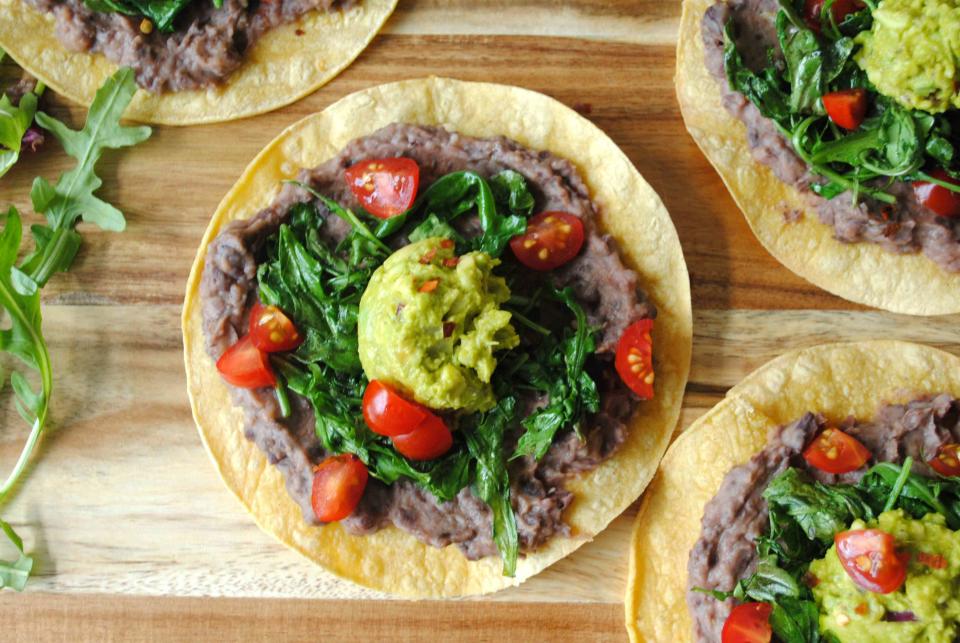
Verywell / Stephanie Clarke
Medically reviewed by Rochelle Collins, DO
As a vegetarian, you must pay attention to the nutrients in your diet. Some of these key nutrients are protein, calcium, vitamin B12, vitamin D, omega-3 fatty acids, zinc, and iron. Other than vitamin B12, plenty of plant-based foods contain these nutrients.
Iron is particularly important because without it, you may experience fatigue, weakness, and a regular chill in your bones. This is why your diet should included plenty of plant-based sources of iron, which can be found in legumes (soybeans and chickpeas), grains (like brown rice and oatmeal), nuts and seeds (including squash and cashews), and a bevy of green-leaf vegetables.
If you think iron-rich meals can't be tasty (if not delicious), think again.
This article explains the difference between heme and non-heme iron and spells out how much iron you need in your diet before tempting your taste buds with a full plate of iron-rich meals.
Arm Yourself With the Facts
Find out if you have iron-deficiency anemia with a simple blood test. Anemia is a blood disorder marked by a lack of blood cells, which are necessary to carry oxygen from your lungs to tissues throughout your body. Anemia can make you feel weak and tired, which is why it's known as "tired blood" syndrome.
Heme vs. Non-Heme Iron
An iron supplement is easy to take, but it's harder to know where to start with your diet. First, you should know that there are two types of iron:
Heme: This form of iron comes primarily from animal sources like red meat, poultry, and seafood.
Non-heme: This form of iron stems primarily from plant sources.
As a vegetarian, you should focus on non-heme foods. Luckily, they're easily accessible and offer impressive nutritional value, in addition to iron.
Know the Signs
In addition to weakness and fatigue, the symptoms of iron-deficiency anemia may include:
Abnormal paleness
A desire to eat unusual substances (such as ice)—a condition known as pica
Enlarged spleen
Increased heart rate (tachycardia)
Irritability
Sore or swollen tongue
Nutrient Interactions
Although non-heme iron is easy to obtain, the body doesn't digest it as easily as heme iron. You can help your body by pairing these foods with vitamin C-rich foods. Try citrus and citrus juices, fruits like strawberries, and vegetables like bell peppers. They'll help your body soak up more of the iron.
You may have heard that calcium reduces iron absorption. When it comes to non-heme iron, the research is mixed, but the interaction may be dose-dependent. In other words, calcium may reduce non-heme absorption when consumed in large amounts.
Some iron-rich foods, like spinach, are also high in calcium. But unless you're taking a calcium supplement, the amount you take in through these foods usually won't affect absorption. Also, the typical Western diet is high in enhancers like vitamin C, which may balance these effects.
A dietitian can help you determine how much calcium is too much and if you're getting enough calcium from non-animal sources. Ask your healthcare provider for a referral if you're unsure.
At-Risk Groups
Certain people are more prone to be iron-deficient. They include:
Cancer patients
Frequent blood donors
Infants and young children
People with frequent heart failure
People with gastrointestinal disorders
Pregnant women
Women who have heavy periods
How Much Iron Do I Need?
The amount of iron you need depends on your age.
Sex | Age/Condition | MG/Day |
Male | 19+ | 8 |
Female | 19-50 | 18 |
Female | 51+ | 8 |
Female | Pregnant | 27 |
Female | Lactating | 9 |
These recommended daily intakes are for an average healthy adult. Although your specific needs may vary, know that the iron percentages estimated below are based on a recommended intake of 18 milligrams of iron per day.
A meal with 6 milligrams of iron per serving, for example, offers 6 out of 18 recommended milligrams, or 34% of your daily total. You may not absorb it all, but the recipes and pairings below represent a good start.
Breakfast
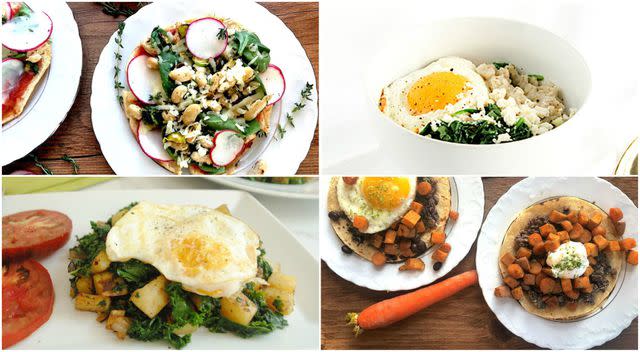
Verywell
Classic breakfast foods—enriched cereals, enriched breads, oatmeal, and eggs, for example—contain iron. Pair them with other high-iron vegetarian ingredients like leafy greens, beans, and veggies to create decadent bowls, pizzas, and breakfast tacos.
You'll start the day strong with these recipes. Per serving, they provide at least 20% of your daily iron target (that's at least 4 mg or more). Round out each meal with a vitamin C-rich sweet treat to help you absorb the iron. A glass of orange or tomato juice, half of a sliced orange or grapefruit, or a cup of strawberries, melon, pineapple, or kiwi are smart choices.
Charred White Bean Breakfast Pizza
Most ingredients in this pizza contribute a bit of iron. You'll get a whopping 6 mg (34%) between the white beans, whole wheat pita, marinara, and spinach.
For 393 calories, you also get 23 g protein, 58 g carbohydrates, 12 g fiber (47%), and more than 20% of your target, for 16 different vitamins and minerals.
Kale and Potato Hash With Fried Egg and Tomato
Kale and potato are the star contributors to most of the iron in this dish. It provides 27% of the daily target (about 5 mg).
For 417 calories, you'll also get 18 g protein, 55 g carbohydrates, 8 g fiber (34%), and more than 20% of your target, for 17 different vitamins and minerals. There's also almost triple your recommended vitamin C amount here, which will help you absorb iron more efficiently.
Savory Spinach and Feta Oatmeal Bowl
Here, the oatmeal, spinach, and egg combine to offer 23% of your iron target (about 4 mg).
For 309 calories, you'll also get 19 g protein, 34 g carbohydrates, 5 g fiber (20%), and more than 20% of your target, for 14 different vitamins and minerals.
Roasted Root Veggie Breakfast Tacos
A cup of canned black beans generally provides 27% of your iron target (about 5 mg). In this recipe, they contribute to a total of 22% (4 mg).
What else do you get? For slightly under 300 calories, enjoy 10 g protein, 48 g carbohydrates, 12 g fiber (47%), and more than 20% of your target, for eight different vitamins and minerals.
Lunch and Dinner
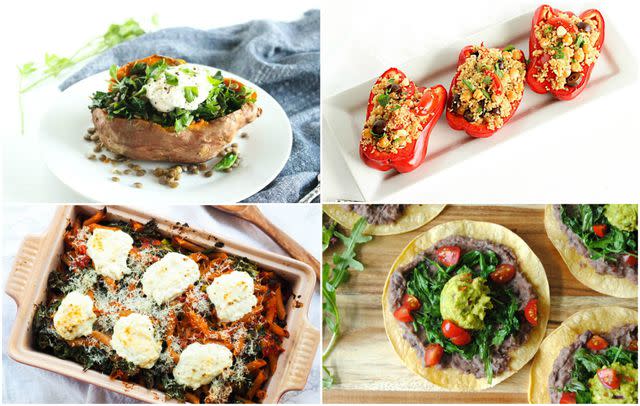
Verywell
Continue racking up iron throughout the day by focusing on fortified whole grains, legumes, and dark, leafy vegetables, such as spinach. They boast impressive nutrient profiles, so should be incorporated into your diet whether or not you're looking to add more iron.
Each of the meals below offers at least 20% of the daily iron target. Seven of the 11 also provide more than 20% of the daily recommended vitamin C amount, which will help you absorb iron more efficiently.
You can also pair your meal with one of these low-calorie, vitamin C-containing drinks:
Strawberry Basil Sparkler: 38% vitamin C per serving
Refreshing and Sweet Cherry Ginger Fizz: 24% vitamin C per serving
Strawberry Green Tea Ice Cubes in Water: 22% vitamin C per serving
Almost any dish with beans is sure to be high in iron. Here, the salsa adds a bit as well, for a total of 26% iron (6 mg).
Along with that, you'll get 461 nutrient-dense calories: 19 g protein, 70 g carbohydrates, 21 g fiber (84%), and more than 20% of your target, for 11 different vitamins and minerals. And although the amount of vitamin C doesn't quite hit the 20% mark, it comes close at 18%.
Vegan Red Curry Lentil Soup With Kale
Legumes are once again the star of the recipe. The lentils in this dish contribute to 30% of iron per serving (about 5 mg). Kale also contains a bit of iron and, along with the tomatoes, contributes a substantial amount of vitamin C.
For 232 calories, you'll also consume 12 g protein, 32 g complex carbohydrates, 10 g fiber (40%), and more than 20% of your target, for 12 different vitamins and minerals, including 52% of vitamin C.
Kale and Lentil Stuffed Sweet Potato
The same star ingredients from the dish above are transformed into a completely different dish with 29% iron (about 5 mg).
For 237 calories, you'll also get 13 g protein, 42 g carbohydrates, 10 g fiber (40%), and more than 20% of your target, for 13 different vitamins and minerals, including 136% of vitamin C.
You'll get quite a bit of iron whether you choose peas or lentils for this dish. Along with the quinoa, the numbers stack up to about 25% iron per serving (5 mg).
This dish contains 330 calories, 18 g protein, 59 g carbohydrates, 16 g fiber (64%), and more than 20% of your target, for eight different vitamins and minerals.
A cup of asparagus is surprisingly high in iron; it offers about 16% of your daily goal. You'll meet 25% of your daily goal (4 mg) when you pair it with peas and quinoa.
The 265 calories per serving come with 10 g protein, 37 g carbohydrates, 8 g fiber (32%), and more than 20% of your target, for nine different vitamins and minerals.
Spring Baked Pasta With Lemon Ricotta
Asparagus isn't the star of this dish, but the iron-rich vegetable is snuck in among whole wheat penne and kale. Together, the three foods rack up 25% of your daily iron goal (5 mg).
The 344 calories per serving offer 19 g protein, 44 g carbohydrates, 6 g fiber (24%), and more than 20% of your target, for 13 different vitamins and minerals. Vitamin C rings in at 95% of your daily goal.
Mediterranean Quinoa Stuffed Peppers
Bell peppers are usually stuffed with iron-rich beef or chicken. This vegetarian version skips the meat but doesn't lose the iron. The quinoa and chickpeas contribute plenty: 25% of your target (4 mg).
There are 346 calories, 13 g protein, 51 g carbohydrates, 11 g fiber (44%), and more than 20% of your target, for 12 different vitamins and minerals. The bell peppers and tomatoes stack up plenty of vitamin C: a whopping 220% of your target.
Stir-Fried Asparagus With Bell Peppers and Cashews
Twenty-two percent iron (4 mg) is impressive for a dish made only of flavorful veggies and nuts. Asparagus and cashews in particular offer plenty of the nutrient.
Enjoy this meal for only 302 calories, with 9 g protein, 25 g carbohydrates, 4 g fiber (16%), and more than 20% of your target, for 9 different vitamins and minerals. The variety of vitamin C-rich veggies racks up 107% of your recommended value.
Ultimate Mediterranean Chopped Salad
Enjoy this salad and add 21% of iron (4 mg) to your daily count. Like all beans, chickpeas are a rich source of iron.
The salad offers an entire meal. It has 383 calories, 14 g protein, 32 g carbohydrates, 9 g fiber (36%), and more than 20% of your target, for 11 different vitamins and minerals.
Black Sesame Tofu Summer Rolls With Peanut Dipping Sauce
Tofu is a common meat replacement in vegetarian dishes. Made of soy, it also contains protein. These summer rolls have 21% iron (about 4 mg). The peanut butter contributes a bit, too.
There are 410 calories per serving, along with 20 g protein, 39 g carbohydrates, and 5 g fiber (20%). Twelve different vitamins and minerals contain more than 20% of your target.
Snacks
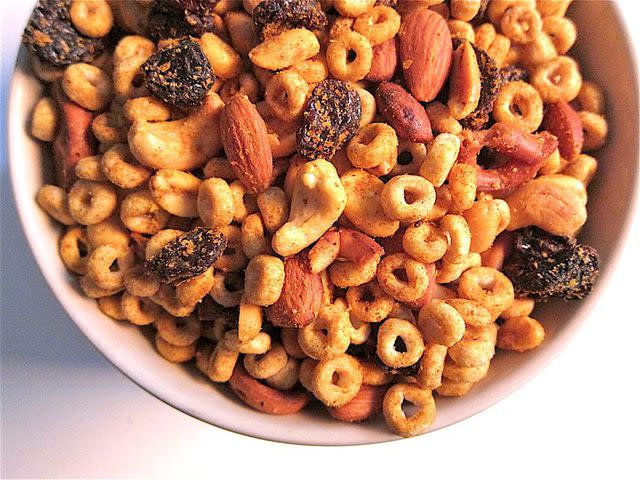
Splitting up any goal into smaller, more manageable pieces is the best way to achieve it. When it comes to meeting nutrient goals, this means getting a bit of the nutrient at every meal, including snacks.
Keep It Simple
Keep snacks simple: Reach for dried fruit like dry apricots, nuts like cashews and almonds, seeds like pumpkin or sunflower, enriched cereals, raw broccoli dipped in hummus or tahini, or even a small salad.
Choose snackable foods that contain a bit of iron. Pair them with a few slices of citrus or a handful of strawberries to increase the iron's availability. You can also combine a few of these foods to make a trail mix-type dish.
The recipe is straightforward. Combine enriched cereal with iron-rich nuts like cashews and almonds, a bit of sweetness, and anti-inflammatory spices for a finger-food treat that has 21% iron per serving (about 4 mg).
As a snack, it's a bit higher in calories, ringing in at 226 per serving. But it does provide a bit of protein and fiber: 5 g and 3 g, respectively.
Dessert
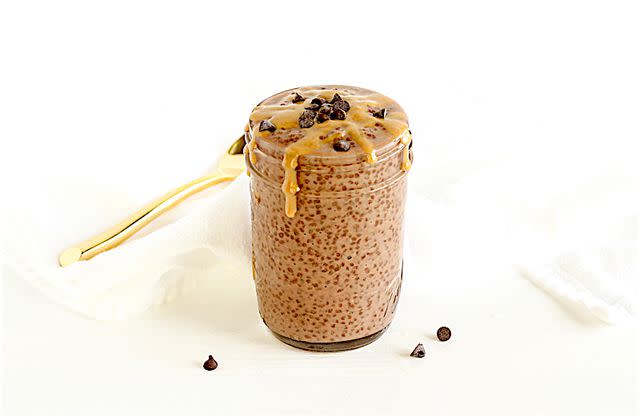
You can't omit dessert if you're spreading out your iron intake throughout the day. An iron-rich dessert will contribute to your daily total.
Peanut Butter Cup Chia Pudding
Chia seeds are impressive all around. They're a great source of fiber and contain protein, heart-healthy omega-3s, and iron. Along with the peanut butter, they contribute 22% (about 4 mg) of iron.
The overall nutrition profile of this dish is also impressive. It clocks in at 415 calories, 20 g protein, 40 g carbohydrates, and 17 g fiber (68%). It has more than 20% of your target, for 11 different vitamins and minerals.
Related: Do You Need an Iron Supplement?
A Word From Verywell
It's possible to get enough iron on a vegetarian diet if you choose nutritious foods and pair them with absorption aids like vitamin C. Mix and match the breakfasts, lunches, dinners, snacks, and desserts outlined here to create a complete meal plan that satisfies your tastes.
If your blood test results still show lower iron, or if you don't notice a change in how you feel, work with a dietitian. They can recommend solutions that fit your specific situation and may recommend iron supplements to help you balance your iron levels. They're available over the counter as well as online.
Frequently Asked Questions
Which foods get in the way of iron absorption?
Polyphenols, nutrients that occur in plants, can block or inhibit iron absorption. These are especially associated with coffee and tea. Calcium and proteins found in animal products (milk, egg whites) and plant products (soy) can also block iron absorption. Eating problematic foods separately from iron-rich foods can help you avoid any interference with absorption.
What quick breakfast foods are high in iron?
Fortified breakfast cereals and whole-grain enriched breads can provide a good iron boost, but beware of milk and coffee at breakfast that can inhibit iron absorption. Add a serving of fresh-squeezed orange juice or another source of vitamin C that helps you absorb the iron.
Are vegetarians at risk for anemia?
They shouldn’t be as long as they eat a well-balanced diet. Whole grains, green leafy vegetables, legumes, seeds, nuts, and iron-fortified cereals can provide sufficient iron, especially when consumed with a source of vitamin C.

